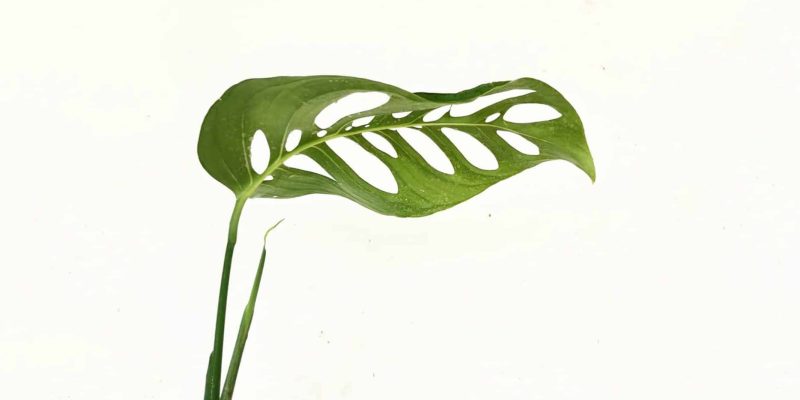Known for its impressive hole-riddled leaves, Monstera esqueleto is a tropical plant that will elevate your indoor jungle and make you the envy of your houseplant addicts support group.
If you’re unsure how to help a Monstera esqueleto plant thrive, we’ll provide you with all the tips and tricks you need. From how to maintain its spooky holes to how it differs from many other monstera species, you’ll be as much of an expert on this plant as you are with your Monstera deliciosa.
(Not there yet? There’s always room for one more!).
So, leaf it to us to guide you through the exciting journey of Monstera esqueleto care!
Table of Contents
Monstera Esqueleto Plant Care Guide
History, Habitat, and Characteristics
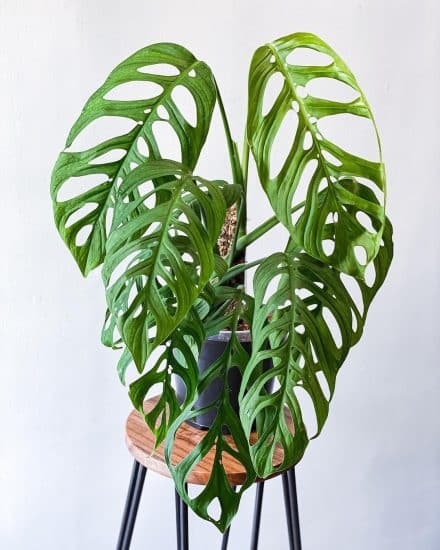
Monstera esqueleto, native to the tropical rainforests of Costa Rica, is famous for its large, delicate leaves that can grow up to a whopping 2 feet or more. These leaves have pronounced, skeletal-like fenestrations that allow more light to reach the plant’s lower leaves in the dense cloud forest understory. Talk about a clever adaptation!
Monstera esqueleto’s scientific name is Monstera epipremnoides, but its common name, esqueleto, actually means “skeleton” in Spanish and Latin. This nickname makes perfect sense when you look at its leaves, with holes so pervasive each leaf looks like a skeleton.
You can easily grow the Monstera esqueleto plant in your home with the right balance of light and moisture. It’s an epiphytic climber, which means it grows on another object or plant for support. This means you’ll need to give your Monstera epipremnoides a sturdy support structure, like a trellis or moss pole, for its strong stems to grow up as it matures.
Like Monstera deliciosa, as Monstera esqueleto grows and matures, its fenestrations become more pronounced and leaves develop a leathery texture. Young plants may start with solid foliage of a lighter green color, but over time, they’ll darken up and transform into the mesmerizing, heavily fenestrated leaves it’s famous for.
Monstera epipremnoides is often mistaken for other monstera varieties, especially Monstera adansonii and Monstera obliqua. Monstera epipremnoides is smaller and less expensive than Monstera obliqua, though, whose fenestrations are even more pronounced than the esqueleto’s, if you can believe it.
Light
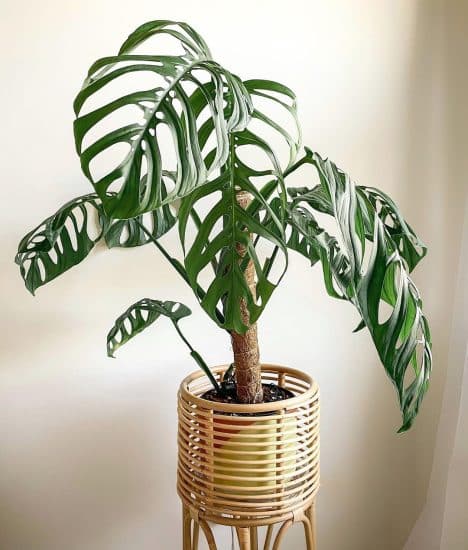
Monstera esqueleto enjoys medium to bright, indirect light and can even handle some direct sunlight. Place it close to east-, west-, or southwest-facing windows, or under a grow light if you don’t have enough exposure. Bright indirect light will help recreate its natural habitat in cloud forests, where the plant receives dappled sunlight.
Signs that your Monstera esqueleto plant isn’t getting enough light include slow or leggy growth where the plant reaches out for more sun, as well as a lack of fenestration on a mature plant. If your mature monstera leaves aren’t splitting, it probably needs more sunlight.
But watch out! If you notice yellow or brown leaves or spots on your Monstera esqueleto, it might be getting too much direct sunlight. You can add a sheer curtain to a bright window to help diffuse direct sun and protect your plant from sun damage, or move to it a spot with more indirect sunlight.
Our lighting tips:
- Provide bright, indirect light with some direct sun in the morning or late afternoon.
- Add a sheer curtain to diffuse too much direct sun.
- Use grow lights to supplement low light exposure.
- Keep an eye on the leaves for signs of too much or not enough light.
Water
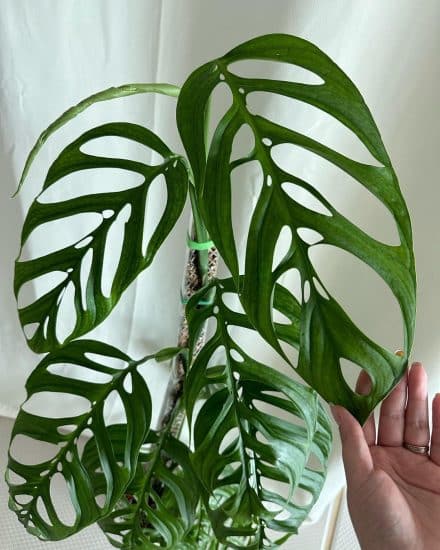
Monstera epipremnoides is a tropical plant, so it likes a potting soil that’s evenly moist — never too wet or too dry. Instead of sticking to a watering schedule, water Monstera esqueleto thoroughly when the top 2 inches of soil have gone dry, allowing the water to flow from the bottom. If you’re not sure it’s dry enough, use a moisture meter to determine soil moisture.
Watering Monstera epipremnoides too much is a common problem. This can cause yellowing, wilting leaves throughout the plant, mushy stems, and consistently soggy soil that doesn’t dry out. If this is the case, you’ll need to cut back on watering and let the soil dry out properly.
If you don’t water your Monstera epipremnoides plant enough, you might notice the leaves turning yellow and curling up, especially those at the bottom. Brown leaf edges are also a sign of insufficient moisture. In this case, water thoroughly and monitor your plant’s soil more frequently to ensure it gets the moisture it needs.
It’s a good idea to mist the leaves regularly — not for moisture, but to reduce dust buildup on the leaves, which can prevent them from taking up as much sunlight as they need. Especially with its large and abundant fenestrations, Monstera esqueleto needs all the help it can get for those leaves to photosynthesize.
Our watering tips:
- Allow the top 2 inches of soil to dry out between waterings.
- Reduce watering considerably during the winter.
- Monitor the leaves and soil for signs of over- and underwatering.
Temperature and Humidity
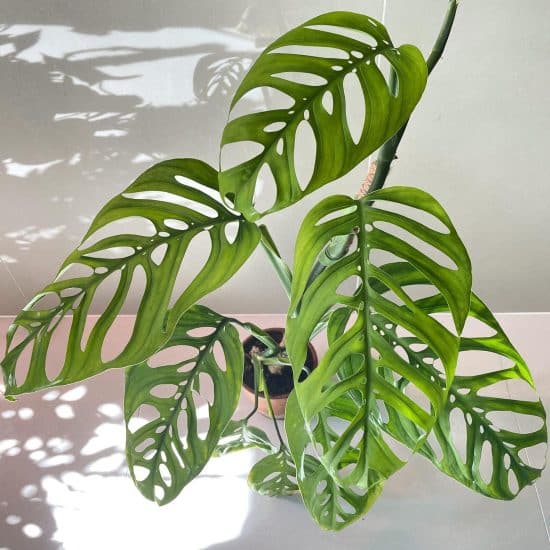
Monstera epipremnoides appreciates warmer temperatures between 65°F-80°F (18-27°C). Be mindful of cold drafts, especially during the winter months, and keep the plant away from frequently open windows or air conditioning units.
Similarly, protect your plant from excessive heat during the hotter months. To maintain healthy leaves, avoid placing your Monstera epipremnoides near radiators or heating vents, as dry, warm air can stress the plant.
Avoiding hot air will also help maintain ideal humidity levels. This tropical plant enjoys a humid environment, so aim for humidity levels between 40% and 60%.
If you notice the edges of the leaves turning brown or the leaves becoming droopy, the humidity level may be too low. If you’re concerned about low humidity, especially during the winter, consider using a humidifier or placing the plant on a tray with water and pebbles.
Soil and Planting
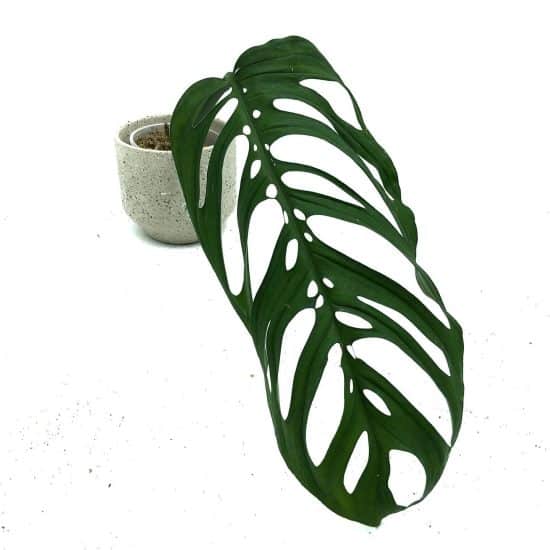
Monstera esqueleto thrives in a well-draining, chunky potting mix that provides the right balance of water retention and aeration for its roots. This mix typically includes coconut husk, or coco coir, as well as pine bark, perlite, and charcoal.
Using the wrong soil mix can cause a host of problems for your Monstera esqueleto. A potting mix that’s too dense can suffocate the roots and prevent them from absorbing nutrients properly.
Some signs of poor soil include:
- Yellow leaves
- Stunted growth
- Wilting despite regular watering
If you notice any of these symptoms, repot your Monstera esqueleto in a high-quality soil mixture to encourage healthy plant growth.
Monstera epipremnoides is a fast grower, so you’ll need to repot about every 1-3 years during the growing season. You can check that the plant is ready to repot by inspecting the roots. If roots are visible on the sides and bottom of the soil, it’s ready to repot.
Plant your Monstera esqueleto in a terracotta pot that absorbs extra moisture and provides proper drainage through drainage holes. You don’t want to choose a pot that’s too much bigger, though, because it will retain too much water in the soil and drown the roots. A few inches wider and taller will do the trick.
Fertilizer
Fertilize your Monstera esqueleto twice a month during the growing season with a balanced houseplant fertilizer. If you want to explore other options, try using hydrolyzed fish and seaweed fertilizer, Cal-Mag, and iron.
Be cautious not to over-fertilize, though, because that can lead to problems like:
- Leaf burn — brown or yellow spots on leaves
- Rapid, weak growth
- Root damage
- Reduced resistance to pests and diseases
If you suspect you’ve used too much fertilizer, give your plant a thorough watering to flush out excess nutrients, and reduce the frequency and amount of fertilizer.
Propagation
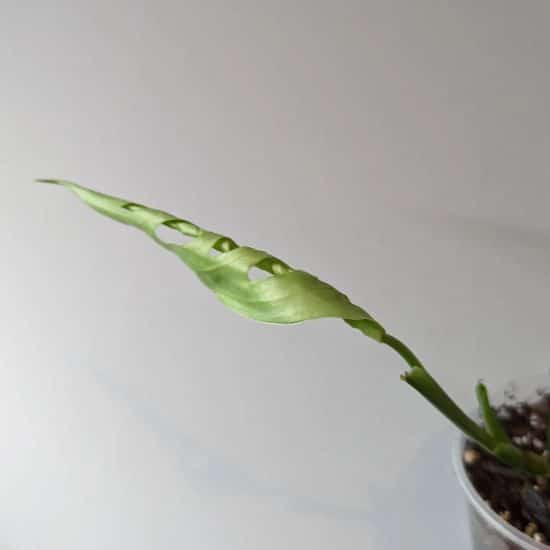
To propagate Monstera esqueleto, you can use stem cuttings or air layering. While using stem cuttings via water or soil propagation is probably a more familiar route, we’ll get into air layering here. It’s a fun and interesting process that doubles as a science experiment!
Propagating Monstera esqueleto by air layering:
- Find the perfect stem: Pick a strong stem with a node (a bumpy spot where leaves and roots sprout from).
- Gather your gear: You’ll need a sharp, clean pair of garden shears or a knife, some coco coir, plastic wrap, and string or twist ties.
- Add water: Soak a handful of coconut coir in water until it’s super moist. Give it a good squeeze to remove the excess water, so it’s damp but not dripping.
- Make a cut: Gently make a shallow cut or notch about 1/3 of the way into the stem, right below the node. This tiny wound will kickstart the root-growing process.
- Wrap it up: Now, wrap the damp coco husk over the cut, and swaddle it in plastic wrap, sealing it well to keep all the moisture in. Use string or twist ties to secure the plastic.
- Root watch: Keep an eye on your plant, checking for root growth every few weeks. Make sure the moss stays moist and happy by adding water if needed. Once the roots reach about 1-2 inches long, move on to the next step.
- Cut and unwrap: Carefully snip the stem below the rooted node using your clean shears. Unwrap the plastic and moss, but be gentle with those delicate new roots.
- Replant the new specimen: Pop the rooted cutting into a pot with high-quality, well-draining soil mix. Water your new plant and find a spot with bright, indirect light for it to thrive.
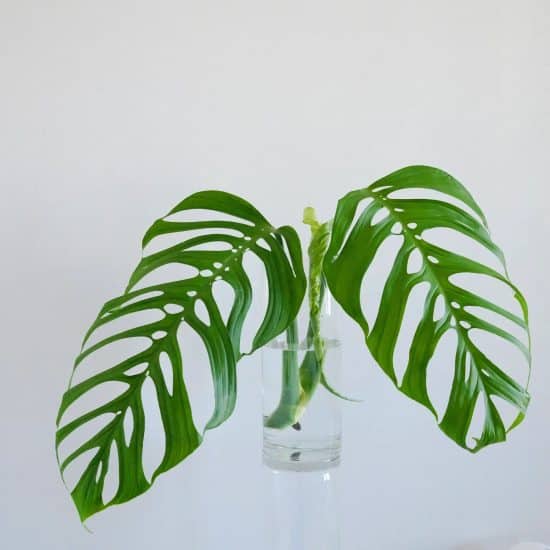
Our propagation tips:
- Ensure the plastic wrap is snug but not strangling the stem. Remember, we want to keep the moisture in but still let the stem breathe.
- If you spot any mold or rot on the wrapped stem, don’t panic! Just remove the plastic, clean the area, and give air layering another shot.
- If your cutting’s taking its sweet time to grow roots, be patient. Cooler temperatures and lower humidity might slow things down a bit, so just check in every few weeks.
- You can also try to propagate Monstera epipremnoides by stem cuttings.
Common Issues
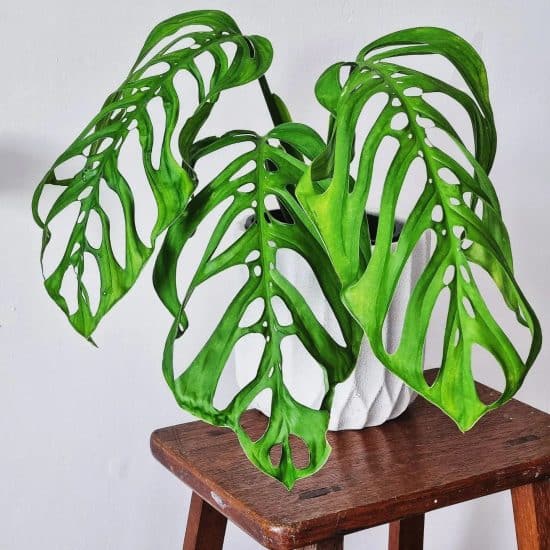
Everybody wants healthy plants, but sometimes it takes a little TLC for Monstera esqueleto to thrive. Here’s how to deal with problems we see often, like small leaves and pesky pests.
Slow Growth or Small Leaves
When your Monstera esqueleto’s leaves seem to be growing way too slowly, or they look smaller than they should, it might be due to a lack of light. To help your plant grow faster and produce larger, mature leaves, move it to a window that gets lots of sunshine.
Another culprit may be a pot that’s too small. If you haven’t repotted your monstera plant in a while, check the root ball to make sure the plant isn’t pot-bound. If you see roots growing outside the soil, give it a larger pot and fresh soil and watch as your plant thrives.
Drooping Leaves
Drooping leaves are a common issue among monstera species. This problem can be caused by many factors, including over- or underwatering, lack of high humidity, or stress from being moved or repotted.
A good rule of thumb is to water your Monstera esqueleto when the top 1-2 inches of soil feels dry. And make sure not to overdo it, or you might end up with more problems (rotting roots, I’m looking at you!).
To increase humidity, run a humidifier nearby or place a tray of water near the base of the plant. This will increase the moisture in the air around the plant.
Lastly, if your Monstera esqueleto is just feeling stressed because of a recent move or repotting, give it some time to adjust to its new home. With proper care and love, it’ll bounce back and thrive before you know it!
Pests and Diseases
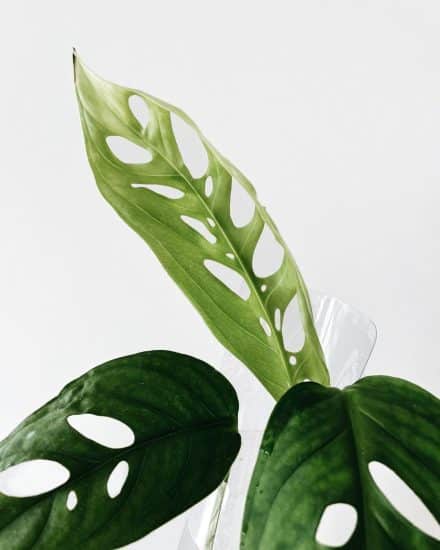
Root Rot
Root rot is a common problem among monstera plants, and it usually happens when the soil doesn’t drain well, drowning the roots in excess water. If you’ve noticed a rotten smell and wilting leaves, you might have a case of root rot.
Here’s how to fix it:
- Gently take your Monstera out of its pot, and examine the root ball. If the roots are black, mushy, and kinda slimy, trim away the diseased roots as well as you can.
- Get a new pot with drainage holes and fill it with a high-quality, well-draining potting mix (hint: look for a mix with perlite or pumice to improve aeration).
- Repot your monstera, and only water when the top 2 inches of the soil feel dry.
We really can’t stress enough how crucial drainage holes are to avoiding root rot.
Pests
Monstera esqueleto can occasionally fall victim to houseplant pests like mealybugs, spider mites, aphids, and scale. If you spot small bugs, weird cotton-like stuff, or webs on your plant’s leaves or stems, it’s pest control time.
Here’s your pest-busting game plan:
- Separate your affected plant from other houseplants. Pests can spread like wildfire!
- Grab a damp cloth or a soft brush to gently remove any visible pests you can find (be thorough, they’re sneaky).
- Treat with an insecticidal soap or neem oil. Apply it to the affected areas, following the directions on the label. Don’t skip the underside of the leaves or any nook and cranny.
To keep your Monstera species pest-free, give them a checkup now and then, and tackle any issues right away. Keep your plants clean by wiping the leaves with a damp cloth, and avoid overwatering and overcrowding, which can make pests feel right at home.
Conclusion
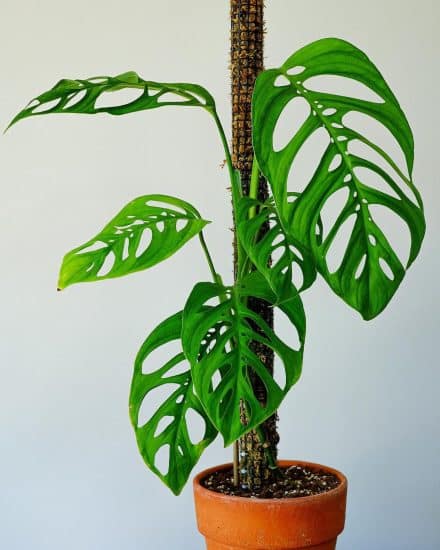
That wraps up our care guide for Monstera esqueleto. You’re now ready and equipped to give these exotic houseplants the love and attention they deserve.
Monstera esqueleto care summary:
- Place in bright, indirect light to ensure healthy growth and vibrant leaves.
- Water when the top 1-2 inches of soil have gone dry.
- Keep humidity levels between 40% and 60%.
- Use a well-draining, chunky soil mix to promote strong root development.
- Apply fertilizer properly during the growing season.
We hope this guide proves helpful in your Monstera esqueleto adventure! If you have any questions or need further assistance, don’t hesitate to reach out on our social media channels. And if you found this article valuable, share the love with your fellow plant enthusiasts!
Happy hole-y growing!
FAQ
Is Monstera esqueleto rare?
Highly sought after for its dramatic, skeletal-like fenestrations, this elusive beauty can be quite the challenge to find. Don’t let its rarity deter you, though!
If you’re lucky enough to find Monstera esqueleto at a local nursery or plant shop, seize the opportunity to add this extraordinary plant to your indoor collection. The Monstera esqueleto’s haunting features are bound to make it the star of your indoor jungle.
What is the difference between Monstera esqueleto vs Monstera adansonii?
Even though they’re both sometimes called the Swiss Cheese Plant because Monstera adansonii leaves also have holes, they’re actually quite different.
The major difference lies in their leaf structure. Monstera esqueleto boasts larger leaves with intricate, skeletal-like fenestrations, which become more pronounced as the plant matures. In contrast, Monstera adansonii showcases smaller, darker green oval-shaped leaves with delicate, evenly spaced holes.
Apart from their leafy differences, Monstera esqueleto and Monstera adansonii also have slightly different care requirements. Although both plants hail from tropical rain forests and appreciate similar temperature and humidity conditions, Monstera esqueleto needs a sturdier support structure (like a trellis or moss pole) to climb on as it grows.
Is Monstera esqueleto a climber?
Absolutely! Monstera esqueleto is from the lush rainforests of Costa Rica, where it climbs its way through dense foliage with ease. In its natural habitat, this plant uses its aerial roots to attach itself to nearby trees, effortlessly scaling great heights in search of sunlight.
If you want to recreate this climbing paradise for your Monstera esqueleto at home, provide it with a robust support structure, such as a trellis, moss pole, or even a piece of driftwood. This will allow your plant to showcase its aerial roots and grow upwards, staying true to its rainforest origins.

